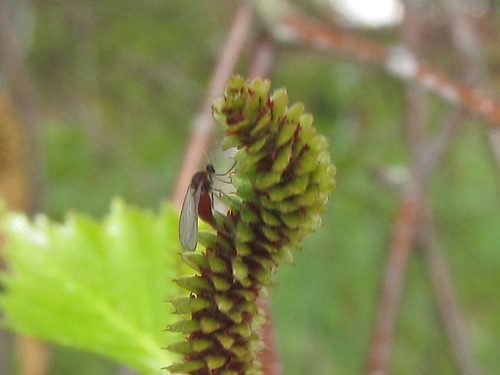Spring Galls 2023 : day 1
Spring Gall week 2023 comes a week or so too early for central England. This year Spring has come slowly, and in fits and starts, with the result that leaf bud burst is only just underway for most trees.
Usually the first new galls of Spring are eriophyid galls on newly unfurled leaves, with Acer, Salix and Crataegus often galling as tge leaves open (I believe the mites overwinter within the bud scales, so can move in immediately). Cecid gall causers tend to be a bit later: early ones are Semudobia sp. Ovipositing into female Betula catkins, and Dasineura tiliae, but neither host is ready yet. Oak Apples should be forming now, but I have only one location close by where I've seen them. Other cynpids on Quercus must await the catkins.
All of this means my initial hunt relied on old galls, a few rusts, and some eriophyid big buds, leaving only about 3 currently tenanted galls out my first day's haul of 17 galls:
- Trioza centranthi. Until 6 years ago this psyllid could not over-winter inland in Britain. A colony was discoveted in Leicestershire in October 2016. I then found it in two locations in Nottinghamshire in early 2019, and discovered one more on checking photos taken even earlier (1st January). Four years down the line the galls are ubiquitous locally, and appear rapidly on new seedlingss.
- Box Leaf Miner: a winter cecid gall on Box. I'm lucky enough to have a local colony, which seems to have survived thebarrival of the Box Moth which has defoliated much of the plant. This is quite diffivult to find, mainly because Box tends to be regularly pruned and the galls/mines are found only in the latest leaves towards the end of a stem. The best bet is to locate Box which has been allowed to grow out: when I was telling Jenny Seawright what to look for she knew such a p.ant close to her, and had photos of the gall the nect day.
- Aceria cephalonea. This required close examination of newly opened Sycamore leaves, the bumps although reddened are stil small, and anthocyanin pigments mask the color difference.
In terms of likely suspects for the remainder of the week, I only have a handful of obvious targets: Marble Gall, two Semufobia, Hollyhock Rust. If leaf burst continues I might find Aceria macrochela, A. myriadum., and Phyllocoptes goniothorax (for some reason both the latter two are quite scarce close to me). A couple of fungal galls are also possible : a smut on Winter Aconite leaves, and both a smut and a rust on Lesser Celandine. The gall I've failed to find this year, which for some reason is a late Winter one locally, is Dasineura violae. All-in-all I don't expect to get to 30 galls in the week. For comparison in early May 2014 I led a gall walk at Attenbourough NR where we found 50 galls in a couple of hours (more eyes does make a big difference).















